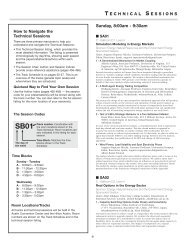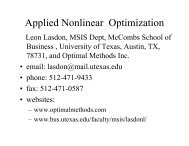[PDF] ALIO Back Matter
[PDF] ALIO Back Matter
[PDF] ALIO Back Matter
You also want an ePaper? Increase the reach of your titles
YUMPU automatically turns print PDFs into web optimized ePapers that Google loves.
MB06<br />
3 - Correct Derivation of Ratio Scaled Priorities From Pairwise<br />
Comparison Matrices<br />
Eng Ung Choo, Professor Eneritus, Simon Fraser University, 8888<br />
University Drive, Faculty of Business Administration, Burnaby, BC,<br />
V5A1S6, Canada, choo@sfu.ca, William C Wedley<br />
Pairwise comparison matrix T can be used to estimate Vb, for some b>0, where V is<br />
a vector of ratio scaled values. We characterize the underlying relevant information<br />
in T which remains invariant when columns of T are reordered and scaled. We<br />
classify the existing methods into different general categories. The multiplicative<br />
form, including the Geometric Mean method is the only simple row by row method<br />
that satisfies the necessary condition for using the embedded relevant information<br />
correctly.<br />
4 - The Multicriterial Decision Aiding in Innovation Management<br />
Jerzy Michnik, Doctor, Karol Adamiecki University of Economics in<br />
Katowice, ul. 1 Maja 50, Katowice, 40-287, Poland,<br />
jerzy.michnik@ae.katowice.pl<br />
Managing innovations is the important factor of firm’s competitiveness and<br />
development. It is also strongly related to strategic choices. Therefore, the decision<br />
process concerning new technologies and products is characterized by a high<br />
uncertainty and many competitive criteria. This work discusses how the decision<br />
process in innovation management can be modeled under the multicriteria<br />
framework in a way that leads to the operationally effective decision aiding.<br />
5 - Normalization Procedure in Multicriteria Decision Making<br />
(Research Project ECO2008-05895-C02-02)<br />
Ethel Mokotoff, Professor, Universidad de Alcalá, Plaza de la Victoria,<br />
3, Alcalá de Henares, Ma, 28802, Spain, ethel.mokotoff@uah.es,<br />
Sergio Barba Romero, Joaquín Pérez<br />
In multi-attribute additive methods, like weighted sum, the obtained global<br />
evaluation of alternatives serves to select one, or to rank the set of them. Recent<br />
publications claim a method that allow to determine the evaluation of a particular<br />
alternative independently of the set of the considered alternatives. The SMC tool, by<br />
Barba-Romero & Mokotoff, includes a normalization procedure whose values,<br />
besides verify the mentioned requirement, avoids the irrelevant alternatives<br />
dependence effect.<br />
■ MB06<br />
Aula 352- Third Floor<br />
Finance: Banking and Risk Management<br />
Contributed Session<br />
Chair: Natallya Levino, UFPE, Lucilio Simıes Souza, 391. Barro Duro,<br />
Maceió, AL, 57045280, Brazil, natallya.levino@gmail.com<br />
1 - Challenges in Portfolio Trading<br />
Youxun Shen, Vice President, Barclays Capital, 17 Fenton Drive,<br />
Short Hills, NJ, 07078, United States of America,<br />
youxun@yahoo.com<br />
In this talk, we will address the challenges faced in portfolio trading. First, we will<br />
discuss how to model the problem in a way such that it is amenable to interiorpoint<br />
algorithm. Then we will explain why variable scaling is key to getting around<br />
numerical instability problems commonly encountered for large portfolios.<br />
Moreover, we will illustrate a soft-constraint approach that is needed to resolve<br />
certain inherent conflicts in user-specified constraints.<br />
2 - Default: An Economic Analysis in Brazil<br />
Maisa Silva, UFPE, Rua Simao Mendes, 92 Apto: 401 Jaqueira,<br />
Recife, PE, 52050110, Brazil, maisa@ufpe.br, Danielle Costa Morais,<br />
Natallya Levino, Ana Paula Cabral Seixas Costa<br />
The present instability in financial markets has led to large macroeconomic changes<br />
such as agent’s income reduction and global economic slowdown. The aim of this<br />
study is to measure the degree of default and to do scenarios simulations of<br />
applications for loans after the financial crisis. For this, we performed a semistructured<br />
questionnaire with post-graduates studying Economics, Business<br />
Administration, Engineering and Accounting in Brazil.<br />
3 - A Comparison Between Different Methods of Quantifying<br />
Operational Risk<br />
Andrés Mora, Colegio de Estudios Superiores de Administración -<br />
CESA, Diagonal 35 No. 5 -23, Bogotá, Colombia, amora@cesa.edu.co<br />
This article employs a LDA approach to quantify OpVaR and uses Monte Carlo<br />
simulation to compare 3 methods. One method employs the g-and-h model. Other<br />
approach is proposed by Bˆcker and Kl¸ppelberg for subexponential losses, and the<br />
last method is based on extreme value theory. Finally, the g-and-h and EVT models<br />
are applied to the losses caused by OpRisk reported by Colombian financial<br />
institutions during 2008 to estimate the 99.9% OpVaR for 2009.<br />
<strong>ALIO</strong> / INFORMS International – 2010<br />
56<br />
4 - Patterns of the Liquidity Preferences After the Financial Crisis:<br />
The Brazilian Case<br />
Natallya Levino, UFPE, Lucilio Simıes Souza, 391. Barro Duro,<br />
Maceió, AL, 57045280, Brazil, natallya.levino@gmail.com, Maisa<br />
Silva, Danielle Costa Morais, Ana Paula Cabral Seixas Costa<br />
The economic and financial crisis that struck several nations reflected in severe<br />
impacts on patterns of liquidity preference of the actors. Thus, the purpose of this<br />
study is to analyse the intention of allocating the financial resources of postgraduates<br />
studying Business Administration and Economics, due to changes in the<br />
behavior of agents after the financial crisis. We performed a qualitative study in a<br />
sample of 58 students between the months of July 2009 and February 2010.<br />
■ MB07<br />
Aula 353- Third Floor<br />
Timetabling<br />
Contributed Session<br />
Chair: María Isabel Restrepo Ruiz, Universidad de los Andes, Carrera 1<br />
No. 18A-10, Bogotá, Colombia, mi.restrepo24@uniandes.edu.co<br />
1 - Tabu Search Algorithm for The Timetabling Problem<br />
Mariela Flores, Universidad Nacional de Salta, Zuviria n∞2275.<br />
Barrio vicente Solá, Salta, 4400, Argentina,<br />
marieladv.flores@gmail.com, Carlos Nocera, Amalia Guaymas<br />
The Timetabling problem has been intensively investigated during the last years due<br />
to the diverse set of variations that arose from the original problem and its<br />
application in different scenarios. We present a particular case of the Classroom<br />
Assignment Problem proposed by PATAT. Our proposal is based on Tabu Search<br />
which contains a constructive phase and several memories to explore in different<br />
solution regions. It was tested over medium and high complexity datasets.<br />
2 - An Evolutionary Algorithm for Solving The Timetabling Problem<br />
for Universities<br />
Xavier Cabezas, MSc, ESPOL, Campus “Gustavo Galindo”, Km. 30.5,<br />
vía Perimetral, Guayaquil, 593, Ecuador,<br />
xavier.cabezas@stat-eeio.com, Fernando Sandoya<br />
In this research is designed and implemented an Evolutionary Algorithm to the<br />
Curriculum-Based Course Timetabling Problem (CB-CTT). Nine restrictions were<br />
considered, four have not infringed any reason (hard) and five that are required to<br />
be minimize (soft). A Genetic Algorithm is designed and implemented it in Matlab<br />
with contributions into the design of the representation of a solution and in<br />
procedures for crossing, mutation and selection, obtaining good results with test<br />
problems proposed.<br />
3 - Multi-activity Shift Tour Scheduling Problem: A Column<br />
Generation Approach<br />
María Isabel Restrepo Ruiz, Universidad de los Andes, Carrera 1<br />
No. 18A-10, Bogotá, Colombia, mi.restrepo24@uniandes.edu.co,<br />
Andrés L. Medaglia<br />
We present a methodology based on column generation to solve the combined<br />
multi-activity shift scheduling and tour scheduling problems. The auxiliary problem<br />
is based on a constrained shortest path, where the harder constraints are embedded<br />
in the underlying graph. The methodology was applied to a company that schedules<br />
security staff and cashiers in parking lots located nearby. The results show a<br />
reduction on staffing costs and better personnel utilization.<br />
■ MB08<br />
Aula 355- Third Floor<br />
Behavioral Decision Making<br />
Sponsor: Decision Analysis<br />
Sponsored Session<br />
Chair: Manel Baucells, Universitat Pompeu Fabra, Ramon Trias Fargas<br />
25-27, Barcelona, 08005, Spain, manel.baucells@upf.edu<br />
1 - Engineering Happiness<br />
Rakesh Sarin, University of California-Los Angeles, Anderson School<br />
of Management, 110 Westwood Plaza, Los Angeles, CA, 90095,<br />
United States of America, rakesh.sarin@anderson.ucla.edu,<br />
Manel Baucells<br />
We present seven laws of happiness that are universal and constant. We argue that<br />
by understanding these laws everyone can improve his/her level of happiness. Using<br />
these laws and a simple mathematical model, several recommendations for<br />
allocating time and resources to maximize happiness emerge. The connection of our<br />
work with the findings in psychology, philosophy and economics will be provided.


![[PDF] ALIO Back Matter](https://img.yumpu.com/17932960/36/500x640/pdf-alio-back-matter.jpg)
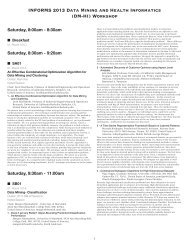
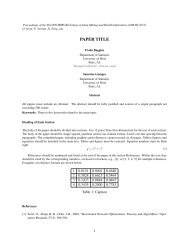
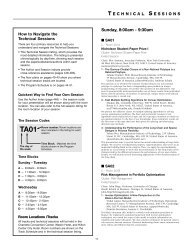
![[PDF] Charlotte Back Matter](https://img.yumpu.com/17933057/1/190x245/pdf-charlotte-back-matter.jpg?quality=85)

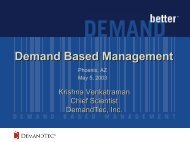
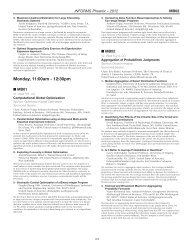
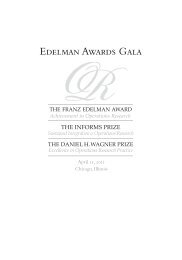
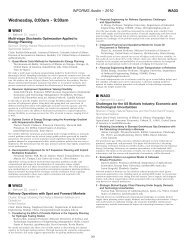
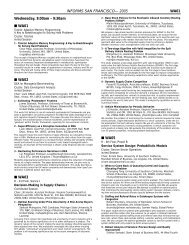
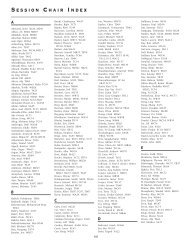
![[PDF] Monday, 8:00am - 9:30am](https://img.yumpu.com/17932954/1/190x245/pdf-monday-800am-930am.jpg?quality=85)
